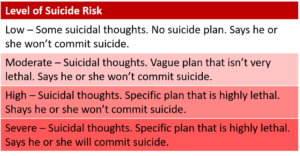By: Ashley Hemrich, M.A. Regional Director of Clinical Partnerships
With the sudden and unexpected deaths of three well-known celebrities, we, as a society, reflect on what may have changed the course for these respected individuals. Robin Williams, Kate Spade, and Anthony Bourdain were all woeful souls who lost their battles with psychological struggles, which resulted in completed suicide. It is with great sadness that we remember the legacies these talented professionals left behind. It is with long overdue intention that we begin this conversation about suicide TODAY. Let’s face it, suicide is not a new topic of conversation, nor is it just “a celebrity problem.” Suicide is a leading cause of death worldwide. According to the American Foundation for Suicide Prevention, approximately 45,000 Americans die of suicide each year, meaning that on average, there are 123 suicides per day. With these numbers continuing to rise, we have a duty to act NOW.
What is Suicide and Differences in Behaviors?
Many of us are aware that suicide is the act of taking one’s own life. However, there are differences in suicidal and parasuicidal behaviors. Suicidal behavior is any action that results in death, (e.g., intentional overdose, intentionally crashing one’s car, etc.). Conversely, the parasuicidal behavior is an action that likely does not result in death (e.g., cutting or scratching one’s arms to draw blood, repeatedly hitting or kicking oneself which induces bruising, etc.). As a society, we typically group suicidal and parasuicidal behaviors since we believe they are similar. The difference between the two is the “intent” behind the action. With suicidal behavior, there is typically an intention to die; end one’s life. On the other hand, the parasuicidal behavior is more of an impulse to relieve pain in that very moment without the intention to take one’s life. Once you can differentiate some of the differences in behaviors, the more likely you can begin to understand the individual’s struggles and how to act appropriately.
Common Misconceptions of Suicide
“People who talk about suicide won’t truly do it.”
Many individuals who attempt to complete suicide successfully give clues and/or warning signs. Never ignore suicidal threats, such as: “Things would be better if I were dead.” “There is no way out.” “I feel so hopeless; I just want to end it right now.”
“Anyone who tries to kill themselves must be foolish and irrational.”
Many people who contemplate suicide are not actually clinically diagnosed with a psychological disorder. But instead, they may feel hopeless, powerless, grief-stricken, and find that there is no way out of their despair. They may feel as though suicide is the only option after many unsuccessful attempts at trying to heal on their own.
“If a person is determined to kill themselves, then nothing is going to stop them; why bother trying to talk to them.”
This statement could not be further from the truth. Even the most determined person still has mixed feelings about taking their own life. All it would take is one person to turn it around for the individual in contemplation. Never doubt the impact you may have on another person suffering.
“People who contemplate suicide are unwilling to seek help.”
According to the American Foundation for Suicide Prevention, more than 50% of suicide victims sought help at least six months before their deaths. Yes, there are those who may not seek help and believe that they can fight the battle on their own; however, that does not necessarily mean that they are “unwilling” to seek help. It may be a byproduct of limited resources, strained relationships, and not knowing where to turn for support.
“Talking about suicide gives someone the idea to commit suicide.”
Research has shown that discussing the topic of suicide with someone in contemplation is one of the most helpful things you can do to change their perception about moving forward with taking their life. As a society, the topic of suicide makes us uncomfortable, better yet, talking about our psychological health is still considered a taboo topic. However, have you ever stopped to think about how a person may feel to know that you care enough to broach that subject with them? That you can tell they are struggling and you are there to help, by just asking questions and providing a listening ear? Sure, they may completely disregard your questions and say they are “absolutely fine” at that moment, but your concern could be the differentiating factor when they feel as though suicide is their only option.
According to the American Association of Suicidology, below are Common Warning Signs:
- Talking about Killing or Harming Oneself
- “I wish I had never been born…”
- “Nobody would care if I died; I’d be better off dead…”
- “If I ever see you again…”
- Talking or Writing About Death and Dying
- We live in a society where social media is an active part of our connections with others. Many times, those in suffering will post such narratives, poems, and even photos as cries for help. Please do not ignore or disregard them.
- Seeking out Lethal Means
- Immediate access to weapons and/or actively purchasing lethal means for the sole intent to end one’s life (e.g., buying a gun, hoarding medication) access to weapons and/or actively purchasing lethal means for the sole intent to end one’s life (e.g. buying a gun, hoarding medication)
- Feelings of Hopelessness
- **Strong predictor of suicide contemplation
- The belief that things will never get better or change for the better
- “I have nothing to look forward to…”
- “I will never feel better…”
- Saying Goodbye
- Unusual or unexpected visits or phone calls to loved ones
- Saying goodbye to people as if they will never see you again
- Perfecting a living will and/or giving away their prized possessions
- Withdrawing from Others
- Increased social isolation
- Feeling like a burden to others—increased guilt, shame, & self-hatred
- **Sudden Sense of Calm & Peace
- **This sudden sense of calm and peace is typically mistaken for a positive outcome. We often believe that the individual is “feeling better” and not contemplating suicide. This may be the strongest indicator in which they have made the decision to commit suicide and have mapped out when, where, and how they will follow through on their choice.
Suicide and Eating Disorders
Frequently, eating disorders are accompanied by thoughts of suicide. In fact, eating disorders have the highest mortality rate of all psychological disorders with suicide being the most common cause of death (1 in 5) among these individuals. Research found that those suffering from eating disorders had significant increases in completed suicide and suicide attempts when compared to individuals who do not suffer from eating disorders. The increased feelings of hopelessness and social isolation coupled with inadequate sustainable nourishment are a very unfortunate recipe for increased suicidal thoughts and actions. A recent clinical longitudinal study found that suicidality was a strong predictor of shorter time to death in clients suffering from bulimia and that mortality rates for those suffering from binge eating disorder are on a rapid rise, as well.
Barriers to Seeking Help
The most important reason we see as a barrier to seeking help is a low perceived need by the individual in contemplation. As mentioned previously, our society continues to stigmatize the topic of mental health, and for this reason, many people continue to struggle. The reality is that the problem is bigger than the individual and needs to be addressed by a professional; it typically does not get better on its own. Another common barrier is the lack of knowledge regarding available means of help. “Where do I go?” “Who do I talk to?” “What do I say?” “What happens next?” The internet can be a great tool; yet, it can also steer those in contemplation to an even more difficult place; this is where YOU can make a difference.
Approaching the Conversation
Prevention Tip #1: Speak UP
The best way to find out if someone is suicidal is to ASK. Giving the individual in contemplation the opportunity to express their feelings can provide relief from hopelessness and provide comfort in knowing that you care enough about them to ASK. Below are some ways in which to approach the question:
- “I have been concerned about you lately…”
- “Recently, I have noticed some differences in you and wondered how you are doing?”
- “I just wanted to check in with you because you haven’t seemed like yourself lately. Is there something going on that you want to talk about.”
If someone is contemplating suicide:
- “When did you begin feeling like this?”
- “Did something happen that made you feel this way?”
- “How can I best support you right now?”
- “Have you thought about seeking help?”
- “You are not alone in this. I am here for you.”
- “I may not understand how you feel, but I care enough about you and want to help.”
What NOT to do:
- Argue with them
- “You have so much to live for, stop it.”
- Act shocked, lecture the individual on the value of life, give advice, OR tell them your views on suicide
- These reactions will only hinder the individual in contemplation from seeking the help that they need during this critical time.
- Promise complete confidentiality
- “You can talk to me; I won’t tell anyone.”
Prevention Tip #2: Respond Quickly
Please note that no matter the level of suicide risk, the timing of your response should be quick and supportive.
Those at highest risk of suicide:
- Have a specific suicide PLAN
- “Do you have a plan to commit suicide?”
- Have the MEANS of carrying out the plan
- “Do you have what you need to carry out your plan?”
- Have a TIME FRAME of committing suicide
- “Do you have an idea of when you are planning to carry out your plan?”
- Have an INTENTION of following through with the plan
- “Do you intend to die?”
**NEVER LEAVE THE PERSON ALONE and NEVER DISREGARD THEIR INTENTIONS
Prevention Tip #3: Offer Help
The best way in which you can help someone in contemplation is by offering a supportive and active listening ear. All too often, we do not practice actively listening, but instead, spend our time thinking about the next thing to say. When someone is actively contemplating suicide, listen to them. Provide support and help them seek professional help at that moment. The National Suicide Prevention Lifeline (1-800-273-TALK) provides toll-free, 24/7 immediate professional care for those in suicidal crisis or emotional distress. You can also contact 911 for immediate assistance to the local emergency room.
We, cannot just ignore the topic of suicide because it makes us feel uncomfortable or project hope that the thoughts go away on their own. No, we must act, listen, and be actively present for those who may be struggling every single day.
If you or someone you know is struggling with suicidal thoughts or actions, please seek professional support.
______________________
“So do not fear, for I am with you; do not be dismayed, for I am your God. I will strengthen you and help you; I will uphold you with my righteous right hand.” Isaiah 41:10

 Call
Call


